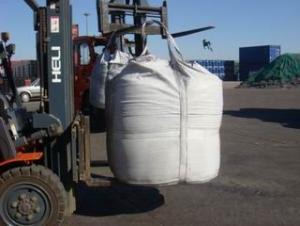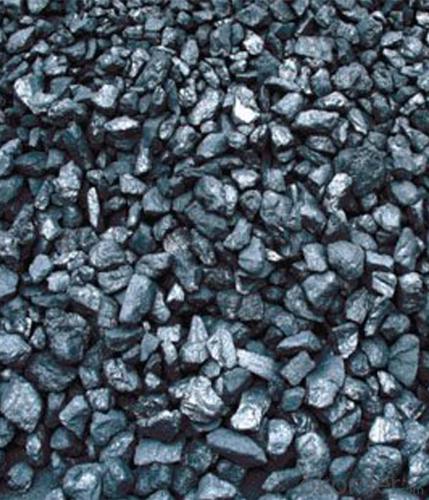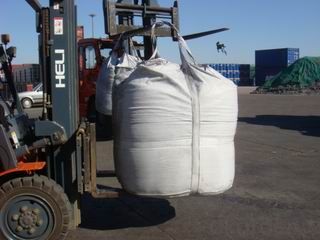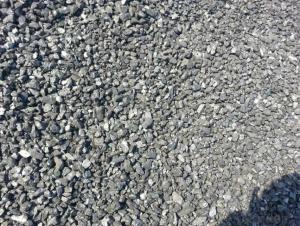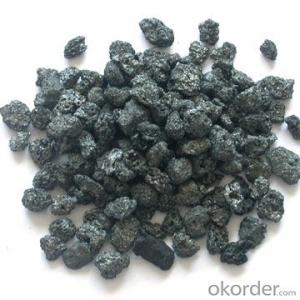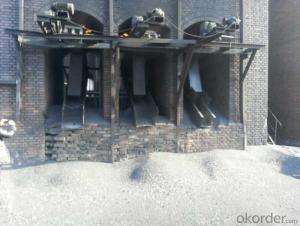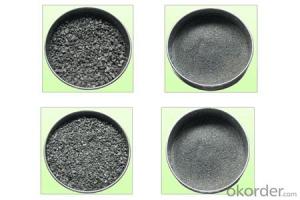FC 93 percent Carbon Additive Supplied By CNBM China
- Loading Port:
- China main port
- Payment Terms:
- TT or LC
- Min Order Qty:
- 30 m.t.
- Supply Capability:
- 1000 m.t./month
OKorder Service Pledge
OKorder Financial Service
You Might Also Like
Specifications
Calcined Anthracite
Fixed carbon: 90%-95%
S: 0.5% max
Size: 0-3. 3-5.3-15 or as request


Calcined petroleum coke is formed from the by-product of crude oil distillation. Available in wide ranges of types and morphologies to meet the application,
these materials have a dark, flat sheen. They are high in carbon but have reduced lubrication, electrical
and thermal conductivity properties, and are mainly used as a filler.
PARAMETER UNIT GUARANTEE VALUE | |||||
F.C.% | 95MIN | 94MIN | 93MIN | 92MIN | 90MIN |
ASH % | 4MAX | 5MAX | 6MAX | 7MAX | 8MAX |
V.M.% | 1 MAX | 1MAX | 1.5MAX | 1.5MAX | 1.5MAX |
SULFUR % | 0.5MAX | 0.5MAX | 0.5MAX | 0.5MAX | 0.5MAX |
MOISTURE % | 0.5MAX | 0.5MAX | 0.5MAX | 0.5MAX | 0.5MAX |
Size can be adjusted based on buyer's request.
Pictures of Calcined Anthracite:


We can supply below furnace charges, please feel free to contact us if you areinterested in any of any of them:
Coke (Metallurgical, foundry, gas)
Calcined Anthracite with fixed carbon from 90% to 95%
Our Service:
1. Your inquiry related to our products or prices will be replied in 24hours.
2. Manufacturer with large capacity, ensure the fast production cycle after confirmed the order.
3. Our professional technicians will answer your entire enquiry in patient.
4. To meet the refractory solutions, we can serve as your instructions.
5. Protection of sales area and private information for our entire customer.
- Q: What is the relationship between carbon and climate change?
- The relationship between carbon and climate change is that carbon dioxide (CO2), primarily emitted through human activities such as burning fossil fuels, is a greenhouse gas that contributes to the warming of the Earth's atmosphere. The excessive release of CO2 traps heat, leading to a rise in global temperatures and subsequent climate change impacts such as melting ice caps, rising sea levels, extreme weather events, and disruptions to ecosystems.
- Q: What is diamond?
- Valued highly for its exceptional hardness, brilliance, and rarity, diamond is a precious gemstone. It is a form of carbon that has undergone intense heat and pressure deep within the Earth's mantle, resulting in its unique crystal structure. Diamond is known for its dazzling sparkle and is transparent and colorless, though it can also occur in various colors, such as yellow, blue, pink, and green, due to impurities during its formation. The brilliance of diamonds is maximized by cutting and polishing them into different shapes, making them popular in jewelry. Moreover, their remarkable durability allows them to be extensively used in industrial applications, including cutting, grinding, and drilling, due to their strength. Ultimately, the extraordinary beauty, durability, and scarcity of diamond have made it one of the world's most sought-after gemstones.
- Q: What are the different types of carbon steel?
- Carbon steel is a versatile and widely used material in various industries due to its strength, durability, and affordability. There are several different types of carbon steel, each with its own unique properties and applications. 1. Low Carbon Steel: This type of carbon steel contains a low amount of carbon, typically up to 0.25%. It is the most commonly used form of carbon steel due to its ease of fabrication, weldability, and affordability. Low carbon steel is used in applications such as construction, automotive manufacturing, and general engineering. 2. Medium Carbon Steel: With a carbon content ranging between 0.25% and 0.60%, medium carbon steel offers increased strength and hardness compared to low carbon steel. It is commonly used in machinery parts, axles, gears, and shafts that require higher levels of toughness and wear resistance. 3. High Carbon Steel: High carbon steel contains a carbon content of 0.60% to 1.00%. It has excellent strength and hardness but is less ductile and more brittle compared to low and medium carbon steels. High carbon steel is commonly used in applications such as cutting tools, springs, and high-strength wires. 4. Ultra-High Carbon Steel: This type of carbon steel contains a carbon content greater than 1.00%, typically ranging from 1.20% to 2.50%. It possesses extremely high hardness and is often used in specialized applications such as knives, blades, and tools that require exceptional sharpness and wear resistance. 5. Carbon Tool Steel: Carbon tool steel refers to a group of steels that contain additional alloying elements such as chromium, vanadium, or tungsten. These alloying elements enhance the steel's hardness, wear resistance, and heat resistance, making it suitable for tool and die making, cutting tools, and molds. It is important to note that the carbon content of steel determines its strength, hardness, and other properties. The choice of carbon steel type depends on the specific application, desired characteristics, and manufacturing requirements.
- Q: What is the structure of a diamond, a form of carbon?
- The structure of a diamond, a form of carbon, is a crystal lattice arrangement where each carbon atom is covalently bonded to four other carbon atoms in a tetrahedral arrangement. This gives rise to a three-dimensional network of carbon atoms with a repeating pattern. The bonds between the carbon atoms are extremely strong, resulting in the hardness and durability of diamonds. The arrangement of carbon atoms in a diamond forms a cubic crystal system, specifically the face-centered cubic (FCC) structure. This means that each carbon atom is surrounded by a total of eight neighboring carbon atoms, creating a dense and tightly packed structure. The strong covalent bonds and the compact arrangement of carbon atoms in the diamond lattice give rise to the unique properties of diamonds, such as their exceptional hardness, high thermal conductivity, and optical brilliance.
- Q: What are the impacts of carbon emissions on the stability of river ecosystems?
- Carbon emissions have significant impacts on the stability of river ecosystems. One of the primary consequences of carbon emissions is the increase in greenhouse gases in the atmosphere, leading to global warming. Rising temperatures have direct and indirect effects on river ecosystems. Firstly, increased temperatures can alter the physical characteristics of rivers and affect the availability of oxygen in the water. Warmer water holds less dissolved oxygen, which can harm aquatic organisms such as fish and invertebrates that rely on oxygen for survival. This decrease in oxygen levels can lead to reduced biodiversity and even fish kills. Secondly, climate change, driven by carbon emissions, can disrupt the natural hydrological cycle. Changes in precipitation patterns can result in droughts or floods, causing fluctuations in river flow. These changes can affect the spawning and migration patterns of many aquatic species, disrupting their life cycles and reducing their populations. Furthermore, altered river flows can also impact the stability of riverbank and riparian habitats, leading to erosion and habitat loss. Additionally, increased carbon emissions contribute to ocean acidification. When carbon dioxide is absorbed by water, it forms carbonic acid, which lowers the pH of the water. Acidic waters can have detrimental effects on aquatic life, including shellfish, corals, and other calcifying organisms. River ecosystems are interconnected with coastal and marine ecosystems, so the impacts of ocean acidification can indirectly affect river ecosystems through the food web. Moreover, carbon emissions contribute to the deposition of air pollutants, such as nitrogen and sulfur compounds, onto land and water bodies. These pollutants can be transported by rainfall into rivers, leading to increased nutrient levels and eutrophication. Excessive nutrients can cause harmful algal blooms, deplete oxygen levels, and create dead zones, further disrupting the balance of river ecosystems. In conclusion, carbon emissions have profound impacts on the stability of river ecosystems. Rising temperatures, altered hydrological cycles, ocean acidification, and increased nutrient levels all contribute to the degradation of these ecosystems. It is crucial to reduce carbon emissions and implement sustainable practices to mitigate these impacts and preserve the health and stability of river ecosystems.
- Q: What are carbon-based superconductors?
- Carbon-based superconductors are a type of material that exhibit superconductivity, a phenomenon where electrical resistance drops to zero at low temperatures. Unlike conventional superconductors, which are typically metallic elements or alloys, carbon-based superconductors are composed primarily of carbon atoms. These materials are known for their unique structure and properties, which make them highly efficient conductors of electricity when cooled below a certain critical temperature. Carbon-based superconductors can be categorized into two main types: organic superconductors and fullerene superconductors. Organic superconductors are made up of carbon-based molecules, such as organic salts or polymers, which form a crystal lattice structure. These materials have been extensively studied and have shown promising superconducting properties at low temperatures. Fullerene superconductors, on the other hand, are composed of carbon molecules arranged in a specific cage-like structure, called fullerenes. The most well-known fullerene is C60, also known as a buckyball, which consists of 60 carbon atoms arranged in a soccer ball-like shape. By doping these fullerene cages with certain elements, such as alkali metals or transition metals, their superconducting properties can be enhanced. What makes carbon-based superconductors particularly interesting is their potential for high-temperature superconductivity. While most conventional superconductors require extremely low temperatures close to absolute zero (-273.15°C or -459.67°F) to exhibit superconductivity, some carbon-based superconductors have been found to retain their superconducting properties at relatively higher temperatures. This property is crucial for practical applications, as it allows for easier cooling and opens up possibilities for widespread use of superconductivity in various fields, including energy transmission, magnetic levitation, and quantum computing. However, it is important to note that carbon-based superconductors are still an active area of research, and many challenges remain in understanding their mechanisms and improving their superconducting properties. Nonetheless, the discovery and exploration of these materials hold great promise for advancing the field of superconductivity and enabling new technological breakthroughs.
- Q: I want to know why the ATP in the five carbon sugar is a DNA RNA??
- ATP (adenosine-triphosphate) Chinese name three phosphate adenosine, also called ATP (adenosine three phosphate), referred to as ATP, which A said adenosine, T said the number is three, P said that the phosphate group, connecting three phosphate groups.
- Q: How does carbon contribute to the strength of alloys?
- Carbon contributes to the strength of alloys by forming interstitial solid solutions with metals, which increases the hardness and strength of the material. The carbon atoms occupy the spaces between the metal atoms, creating lattice distortions and enhancing the overall strength of the alloy. Additionally, carbon can also form compounds with metals, such as carbides, which further improve the hardness and wear resistance of alloys.
- Q: How do you make your own carbon fiber bar?Know. ID is how to make? Don't copy anything that has nothing to do with it
- 4. application development, at present, various applications for carbon fiber annual demand ratio is as follows: sports applications of about 30%, aviation applications for 10%, industrial applications for 60%. Three important applications in sports are the golf club, fishing rod and tennis racket frame. At present, it is estimated that the annual output of big bat is 34 million. According to the national geographic classification, these big clubs are mainly made in the United States, China, Japan and Taipei, China, and the United States and Japan are the main consumer of golf clubs, accounting for more than 80%. 40% of the carbon fiber balls in the world are made from carbon fiber of TORAY. Carbon fiber fishing rods around the world produce about 20 million pairs a year, which means this application has a steady demand for carbon fiber. The market capacity of tennis racket frames is about 6 million pairs per year. Other sports applications include hockey sticks, ski sticks, archery, and bicycles, while carbon fiber is also used in rowing, rowing, surfing, and other marine sports. In 1992, the airline's demand for carbon fiber began to decline, mainly due to the decline of the commercial aircraft industry, but it recovered rapidly in the early 1995. The main reason for the recovery is that the overall efficiency of the production has been improved, but also began to fully produce Boeing 777 aircraft, TORAY carbon fiber has been used
- Q: What are the different types of carbon-based air pollutants?
- There are several different types of carbon-based air pollutants that contribute to air pollution. These include: 1. Carbon Monoxide (CO): This is a colorless, odorless gas produced by the incomplete combustion of fossil fuels, such as gasoline, coal, and wood. It is highly toxic and can be harmful to human health, particularly when inhaled in high concentrations. 2. Carbon Dioxide (CO2): This is a greenhouse gas that is naturally present in the Earth's atmosphere. However, human activities such as the burning of fossil fuels and deforestation have significantly increased its levels, leading to climate change and global warming. 3. Volatile Organic Compounds (VOCs): These are organic chemicals that easily vaporize at room temperature. They are released into the air by various sources, including paints, solvents, gasoline, and industrial processes. VOCs contribute to the formation of ground-level ozone, which is a major component of smog and can be harmful to human health. 4. Methane (CH4): This is another greenhouse gas that is primarily produced by the decomposition of organic materials in landfills, as well as the extraction and transportation of natural gas. Methane is a potent greenhouse gas, with a much higher warming potential than carbon dioxide. 5. Polycyclic Aromatic Hydrocarbons (PAHs): These are a group of chemicals that are formed during the incomplete combustion of organic materials, such as coal, oil, and gas. PAHs are released into the air through vehicle exhaust, industrial processes, and the burning of fossil fuels. They are known to be carcinogenic and can have harmful effects on human health. 6. Formaldehyde (HCHO): This is a colorless gas that is used in the production of resins and plastics, as well as in some building materials and household products. It is released into the air through the burning of fuels, cigarette smoke, and the off-gassing of certain products. Formaldehyde is a known respiratory irritant and can cause allergic reactions and other health issues. These are just some of the carbon-based air pollutants that contribute to air pollution. It is important to reduce emissions of these pollutants through the use of cleaner technologies, energy-efficient practices, and the promotion of renewable energy sources to mitigate their negative impacts on both human health and the environment.
Send your message to us
FC 93 percent Carbon Additive Supplied By CNBM China
- Loading Port:
- China main port
- Payment Terms:
- TT or LC
- Min Order Qty:
- 30 m.t.
- Supply Capability:
- 1000 m.t./month
OKorder Service Pledge
OKorder Financial Service
Similar products
Hot products
Hot Searches

